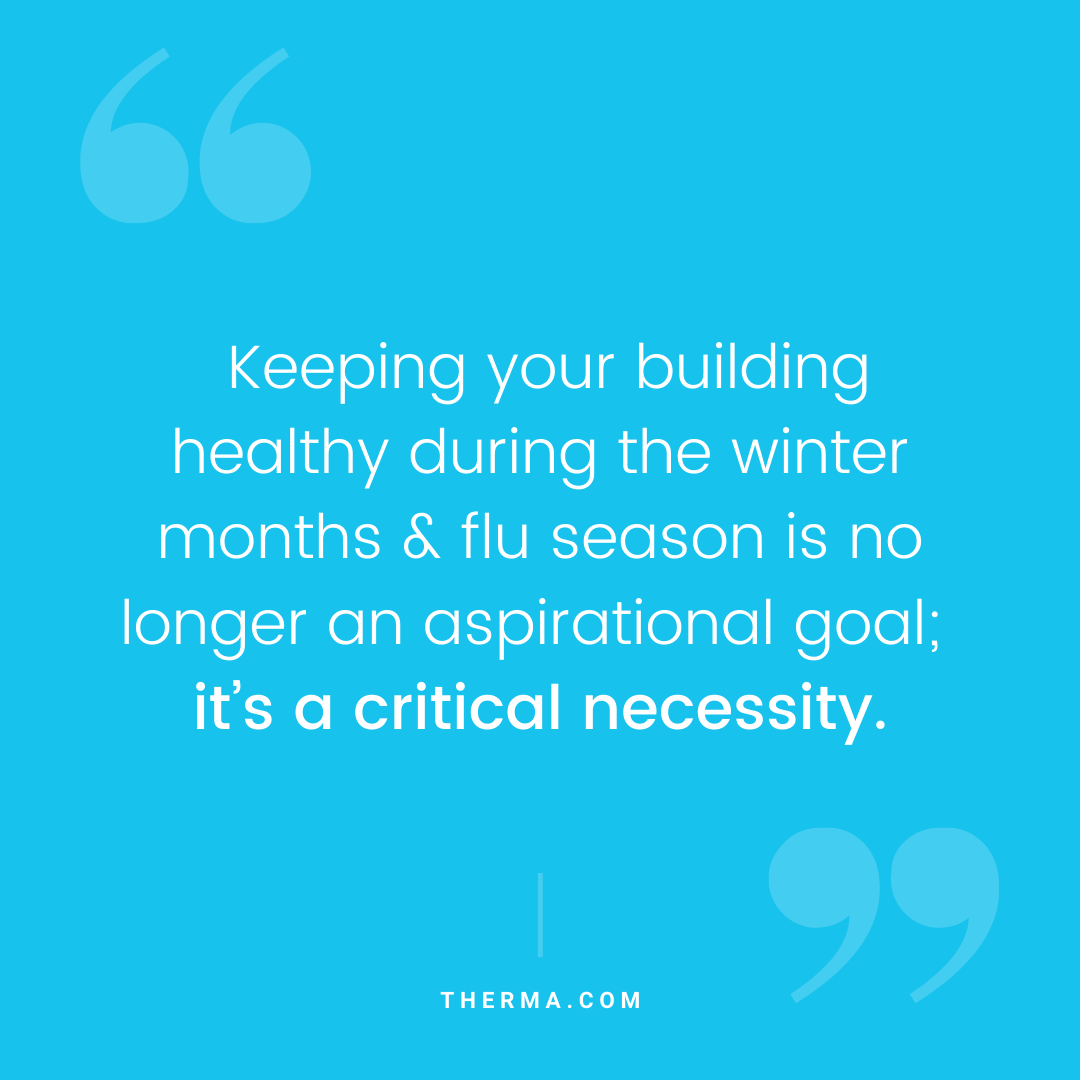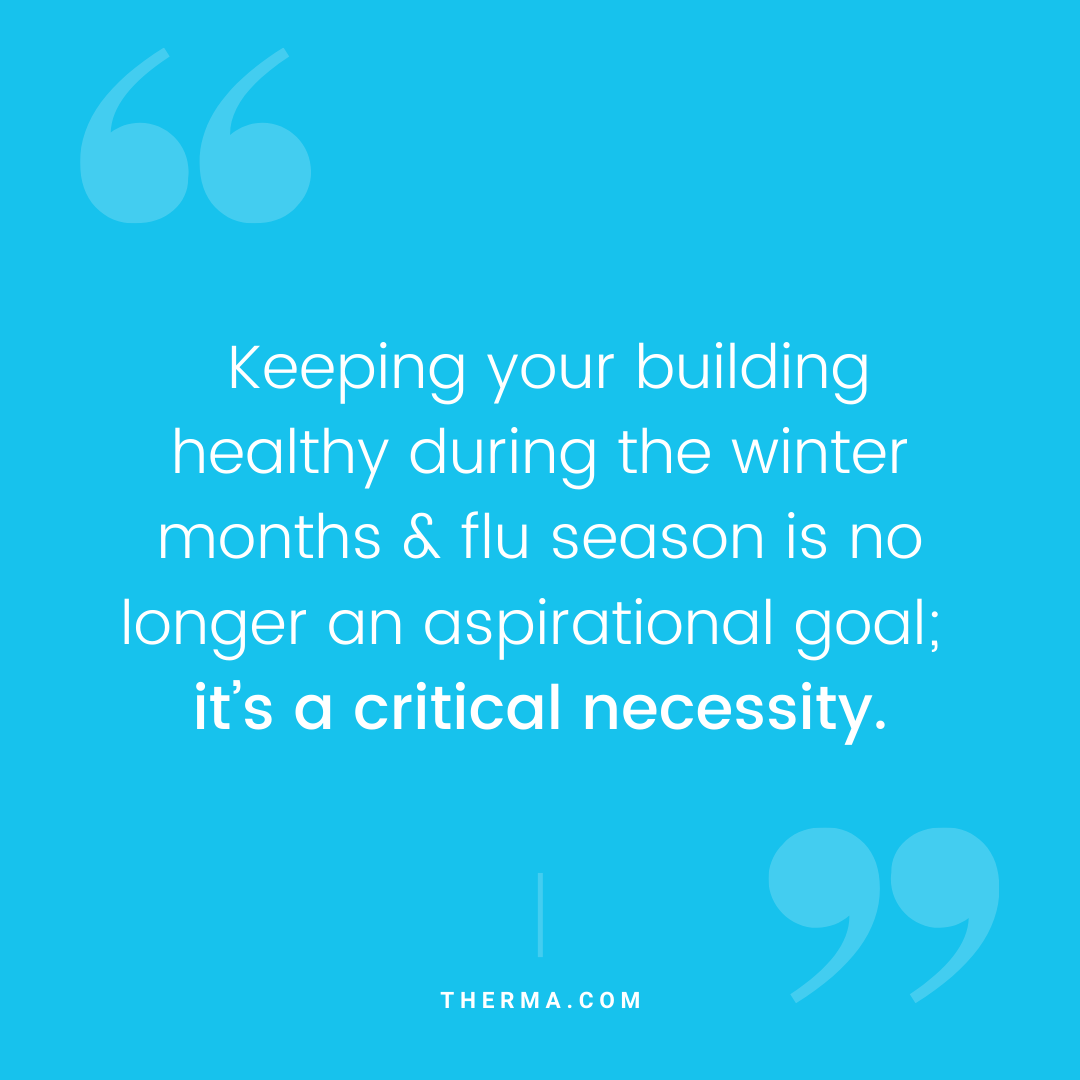As COVID-19 numbers climb across the country, many organizations are beginning to gear up for the upcoming winter months and flu season, knowing it won’t be ‘just another winter.’
HVAC & Flu Season
Some companies are implementing new processes and procedures to reduce or eliminate close contact between building occupants to slow the spread of influenza and coronavirus. A healthy building is not a silo. Its success depends on comprehensive wellness integration throughout the entire facility.
From October 2019 through April 2020, the influenza virus has affected as many as 56 million Americans–roughly 17 percent of the population. When you factor in the current COVID-19 burden of daily new cases numbering in the tens of thousands, you have an increased potential for a critical event. Keeping your building healthy during the winter months and flu season is no longer an aspirational goal; it’s a critical necessity.
Reducing the spread of germs has a real-world impact on your bottom line, lessening workforce downtime by decreasing the number of employee sick days. When people get sick, one of two things happens: either they stay home, causing a drop in business productivity while they’re away, or they go to work, where they potentially spread germs that can, in turn, cause multiple people to become ill and stay away from work causing a drop in productivity…things can quickly get out of control.
Covid-19 and the flu are both community-based diseases; they travel through the air in aspirated droplets, which people can easily pick up from an object, like a stair railing or door handle. This is where HVAC can play an essential role in keeping your building healthy.
Ventilation
With proper airflow and distribution, ventilation can reduce airborne contaminants. Bringing clean, fresh air into a room from outside the building remains the gold standard for indoor air quality (IAQ). It is also one of the most effective methods for reducing the density of harmful pathogens in the air. Additionally, HVAC systems benefit from increased indoor and outdoor air exchange volume.
Airflow
Airflow contributes to the path aerosolized germs travel. HVAC specialists can optimize air distribution by determining the ideal environment to minimize transference, utilizing airflow direction, air velocity, temperature and humidity. The result is fewer building occupants are exposed to germs or viruses in the air.
Organizations can further improve airflow through the evaluation of space usage. When you eliminate bottleneck zones and areas where social distancing is difficult to maintain, you improve airflow.
Air Filtration
The most effective air filters are High-Efficiency Particulate Air (HEPA) filters and they are capable of removing up to 99.7 percent of 0.3 microns, including coronavirus and influenza particles.
HEPA filters are generally installed in HVAC systems to catch particulate matter in the air and prevent it from traveling throughout your HVAC system. Despite its small size ( 0.125 microns), the Covid-19 virus can easily be trapped by HEPA filters.
UV-C Light
UV-C light has been shown to improve IAQ by decreasing microbial build-up within HVAC coils and can eradicate certain bacteria and viruses. Appropriate UV-C light placement can eliminate all pathogens from the air passing through your building’s HVAC unit.
Building Design Considerations Considering HVAC & Flu Season
Workplace trends have seen workspaces develop into densely populated spots that make the successful implementation of CDC COVID-19 guidelines almost impossible. This is pushing some organizations to explore building design considerations as a way to reduce virus transmission.
Installation of automatic door openers, converting elevator panels to those that offer employee recognition from security cards or a fob and replacing touch screens with gesture recognition or voice automation are important tools in the fight against the COVID 19 pandemic and the flu. Additionally, building design adaptability is seeing an increase in demand as organizations look for ways to buy once but get multiple uses out of system upgrades or configuration changes.
While you may need time to determine the best course of action for your facility, there are some simple steps you can begin implementing right away to help keep your building healthy during the upcoming winter months and flu season.
- Stagger shifts, varying start and end times to reduce occupancy overlap, bottlenecks and traffic congestion
- Reduce workspace density, giving more space between building occupants
- Offer onsite temperature or other health screening options
- Provide disposable masks and hand sanitizer at multiple locations throughout your building
- Continually clean, disinfect and sanitize all high-traffic touchpoints
If you are exploring ways to optimize your building for the upcoming winter months, reach out to Therma’s air filtration experts. Our HVAC specialists can help you protect your most important assets: your health and the health of your workforce.









